Financial Analysis Report: Comparing Volkswagen and BMW Financials
VerifiedAdded on 2019/12/03
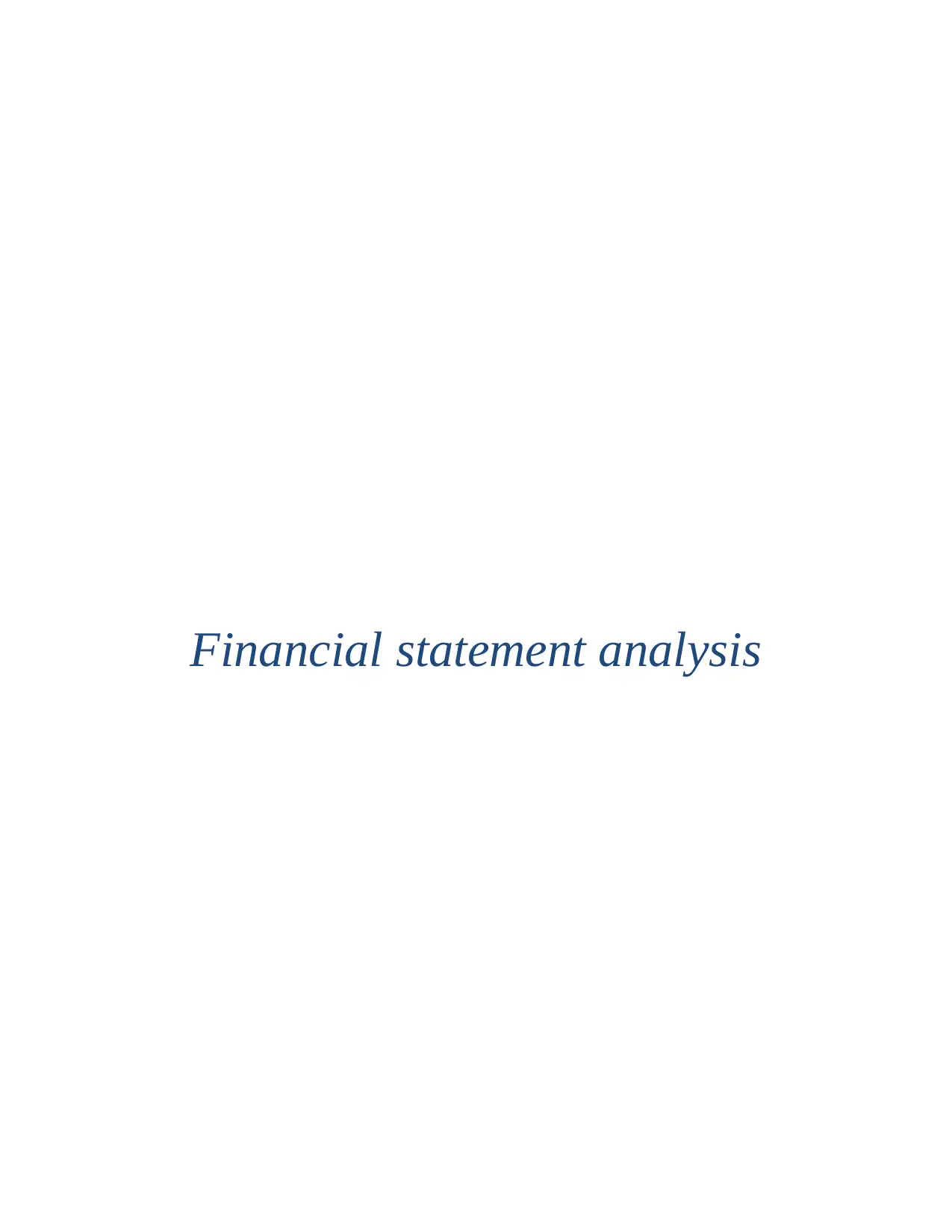
Paraphrase This Document

INTRODUCTION...........................................................................................................................3
Overview of organization................................................................................................................3
APPROACHES TO ANALYZE AND INTERPRETE FINANCIAL STATEMENTS.................3
INTERNAL AND EXTERNAL FACTORS WHICH BRING CHANGE IN THE RATIOS......13
CONCLUSION .............................................................................................................................15
REFERENCES..............................................................................................................................17
2
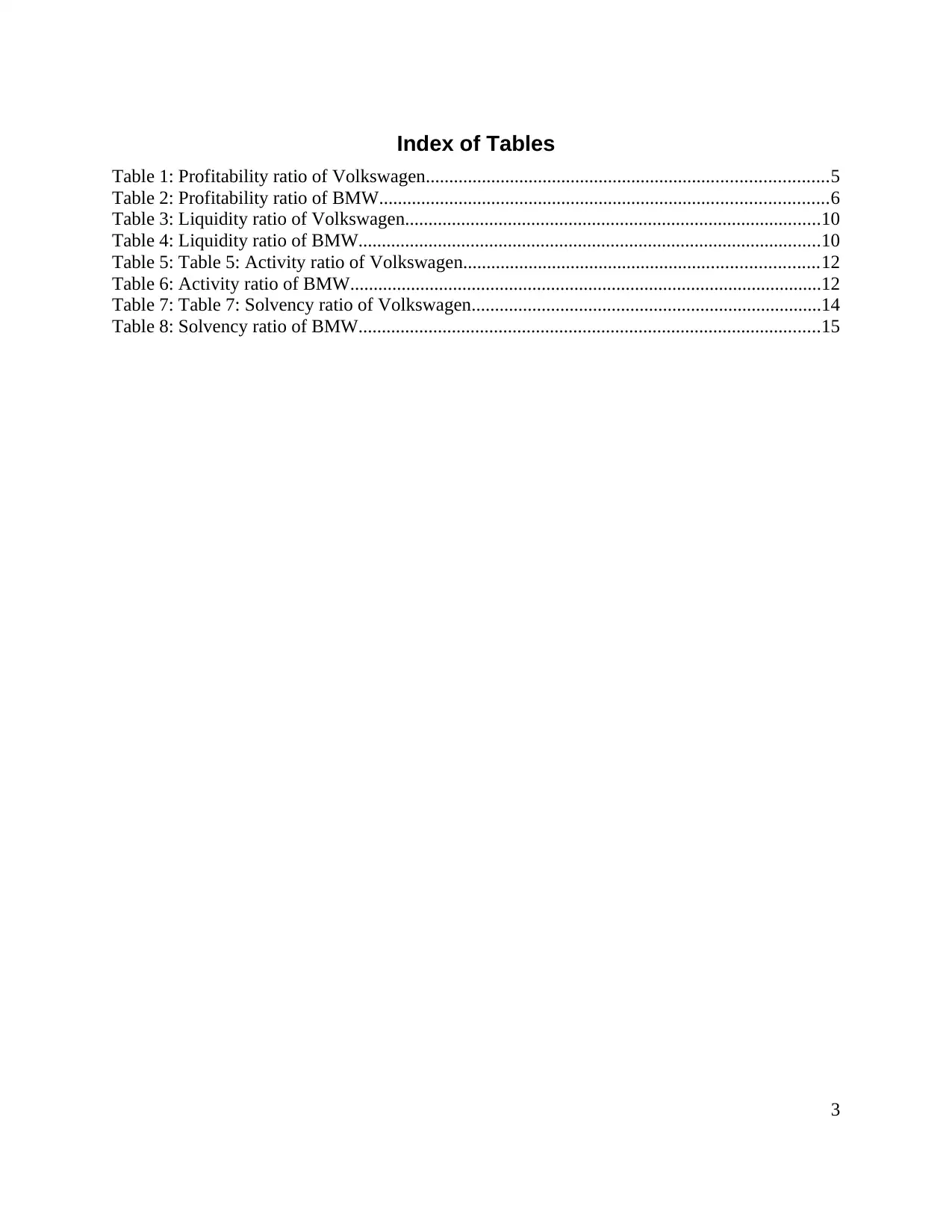
Table 1: Profitability ratio of Volkswagen......................................................................................5
Table 2: Profitability ratio of BMW................................................................................................6
Table 3: Liquidity ratio of Volkswagen.........................................................................................10
Table 4: Liquidity ratio of BMW...................................................................................................10
Table 5: Table 5: Activity ratio of Volkswagen............................................................................12
Table 6: Activity ratio of BMW.....................................................................................................12
Table 7: Table 7: Solvency ratio of Volkswagen...........................................................................14
Table 8: Solvency ratio of BMW...................................................................................................15
3
⊘ This is a preview!⊘
Do you want full access?
Subscribe today to unlock all pages.

Trusted by 1+ million students worldwide
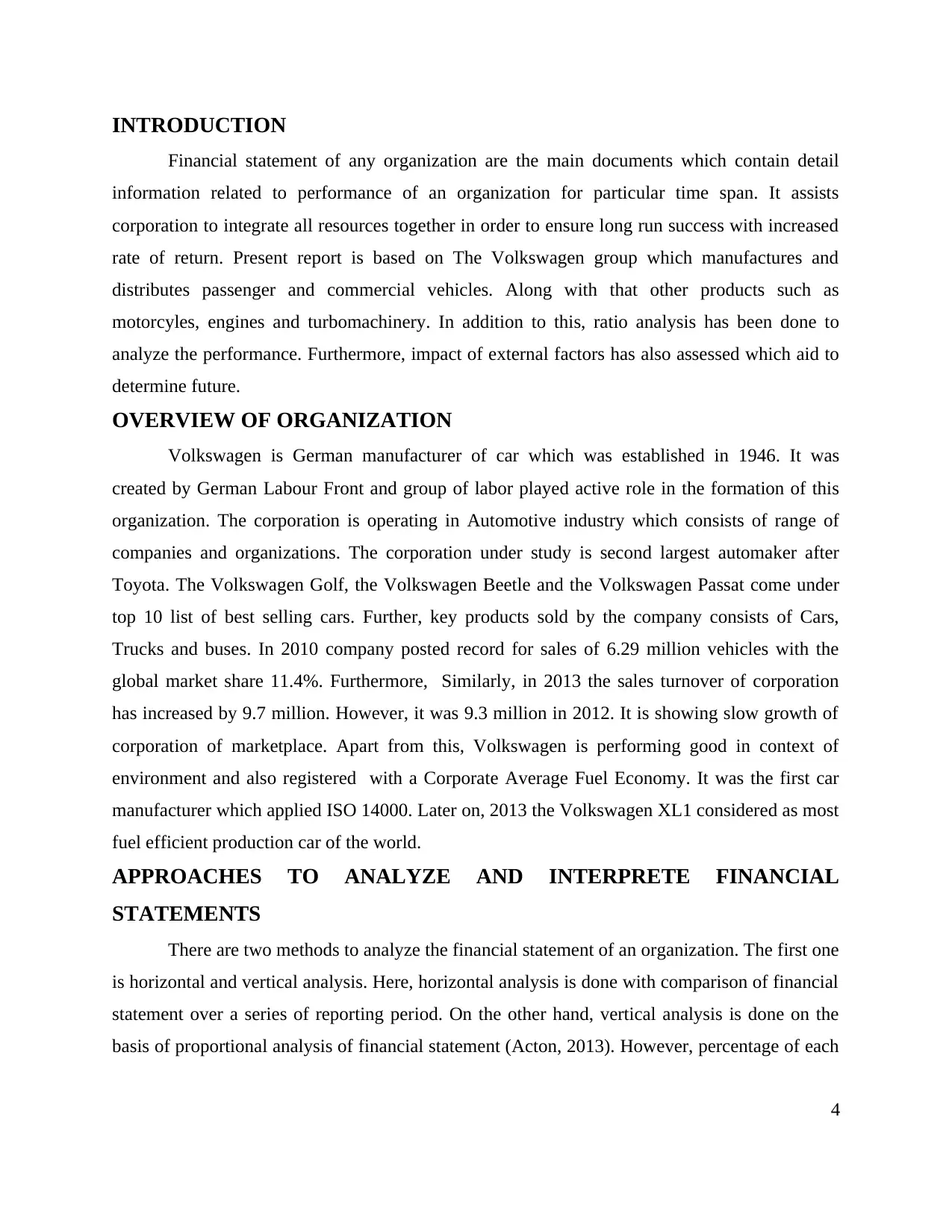
Financial statement of any organization are the main documents which contain detail
information related to performance of an organization for particular time span. It assists
corporation to integrate all resources together in order to ensure long run success with increased
rate of return. Present report is based on The Volkswagen group which manufactures and
distributes passenger and commercial vehicles. Along with that other products such as
motorcyles, engines and turbomachinery. In addition to this, ratio analysis has been done to
analyze the performance. Furthermore, impact of external factors has also assessed which aid to
determine future.
OVERVIEW OF ORGANIZATION
Volkswagen is German manufacturer of car which was established in 1946. It was
created by German Labour Front and group of labor played active role in the formation of this
organization. The corporation is operating in Automotive industry which consists of range of
companies and organizations. The corporation under study is second largest automaker after
Toyota. The Volkswagen Golf, the Volkswagen Beetle and the Volkswagen Passat come under
top 10 list of best selling cars. Further, key products sold by the company consists of Cars,
Trucks and buses. In 2010 company posted record for sales of 6.29 million vehicles with the
global market share 11.4%. Furthermore, Similarly, in 2013 the sales turnover of corporation
has increased by 9.7 million. However, it was 9.3 million in 2012. It is showing slow growth of
corporation of marketplace. Apart from this, Volkswagen is performing good in context of
environment and also registered with a Corporate Average Fuel Economy. It was the first car
manufacturer which applied ISO 14000. Later on, 2013 the Volkswagen XL1 considered as most
fuel efficient production car of the world.
APPROACHES TO ANALYZE AND INTERPRETE FINANCIAL
STATEMENTS
There are two methods to analyze the financial statement of an organization. The first one
is horizontal and vertical analysis. Here, horizontal analysis is done with comparison of financial
statement over a series of reporting period. On the other hand, vertical analysis is done on the
basis of proportional analysis of financial statement (Acton, 2013). However, percentage of each
4
Paraphrase This Document
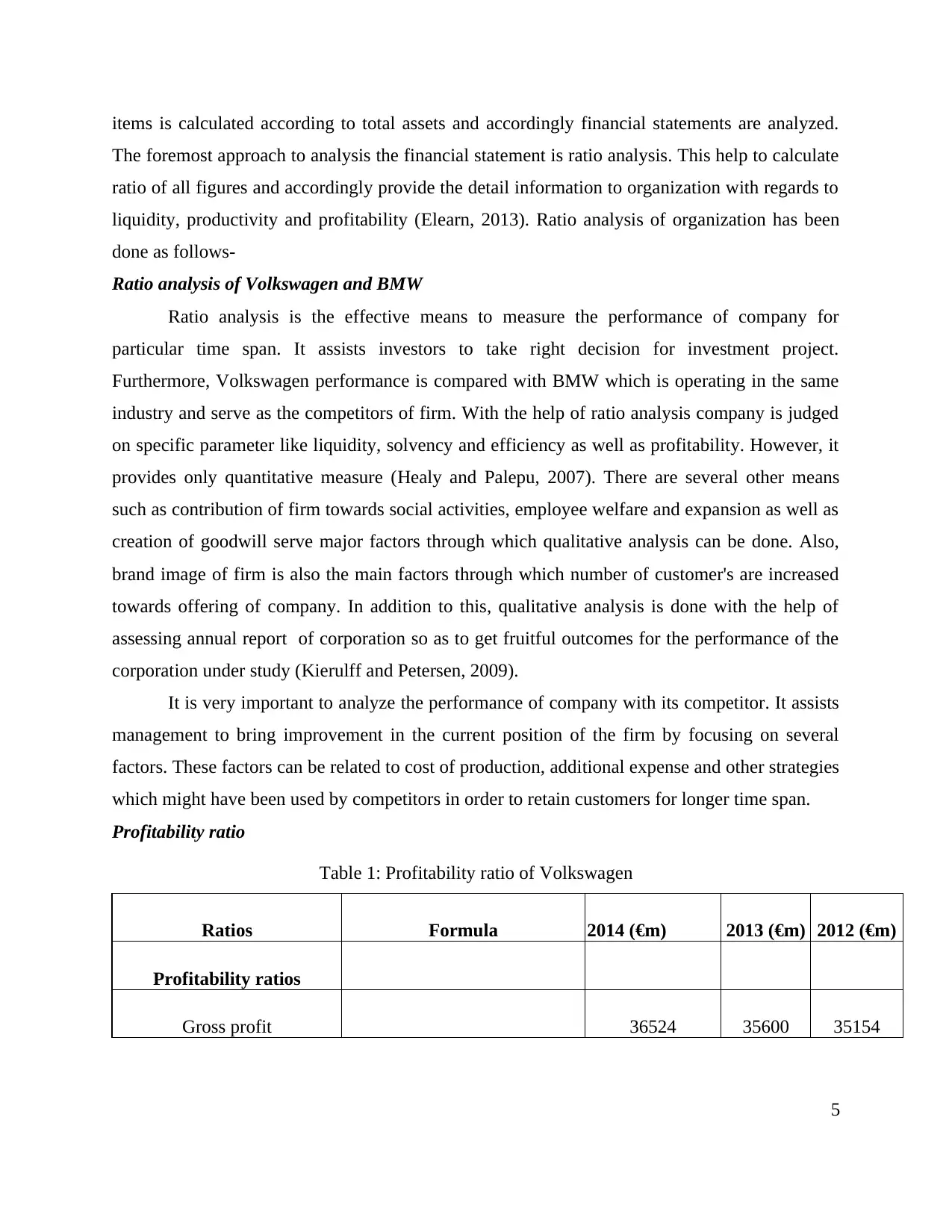
The foremost approach to analysis the financial statement is ratio analysis. This help to calculate
ratio of all figures and accordingly provide the detail information to organization with regards to
liquidity, productivity and profitability (Elearn, 2013). Ratio analysis of organization has been
done as follows-
Ratio analysis of Volkswagen and BMW
Ratio analysis is the effective means to measure the performance of company for
particular time span. It assists investors to take right decision for investment project.
Furthermore, Volkswagen performance is compared with BMW which is operating in the same
industry and serve as the competitors of firm. With the help of ratio analysis company is judged
on specific parameter like liquidity, solvency and efficiency as well as profitability. However, it
provides only quantitative measure (Healy and Palepu, 2007). There are several other means
such as contribution of firm towards social activities, employee welfare and expansion as well as
creation of goodwill serve major factors through which qualitative analysis can be done. Also,
brand image of firm is also the main factors through which number of customer's are increased
towards offering of company. In addition to this, qualitative analysis is done with the help of
assessing annual report of corporation so as to get fruitful outcomes for the performance of the
corporation under study (Kierulff and Petersen, 2009).
It is very important to analyze the performance of company with its competitor. It assists
management to bring improvement in the current position of the firm by focusing on several
factors. These factors can be related to cost of production, additional expense and other strategies
which might have been used by competitors in order to retain customers for longer time span.
Profitability ratio
Table 1: Profitability ratio of Volkswagen
Ratios Formula 2014 (€m) 2013 (€m) 2012 (€m)
Profitability ratios
Gross profit 36524 35600 35154
5

Net profit 11068 9145 21881
Net Sales 202458 197007 192676
Gross Profit Ratio (Gross Profit/ Net Sales) *100 18.04% 18.07% 18.25%
Operating Profit Ratio
(Operating Profit/ Net Sales)
*100 6.27% 5.92% 6.20%
Net Profit Ratio (Net Profit/ Net Sales) *100 5.47% 4.64% 11.36%
Table 2: Profitability ratio of BMW
Ratios Formula 2014 (€m) 2013 (€m) 2012 (€m)
Profitability ratios
Gross profit 17005 15268 15494
Operating profit 9118 7978 8275
Net profit 5817 5329 5111
Net Sales 80401 76059 76848
Gross Profit Ratio (Gross Profit/ Net Sales) *100 21.15% 20.07% 20.16%
Operating Profit Ratio
(Operating Profit/ Net Sales)
*100 11.34% 10.49% 10.77%
Net Profit Ratio (Net Profit/ Net Sales) *100 7.23% 7.01% 6.65%
6
⊘ This is a preview!⊘
Do you want full access?
Subscribe today to unlock all pages.

Trusted by 1+ million students worldwide
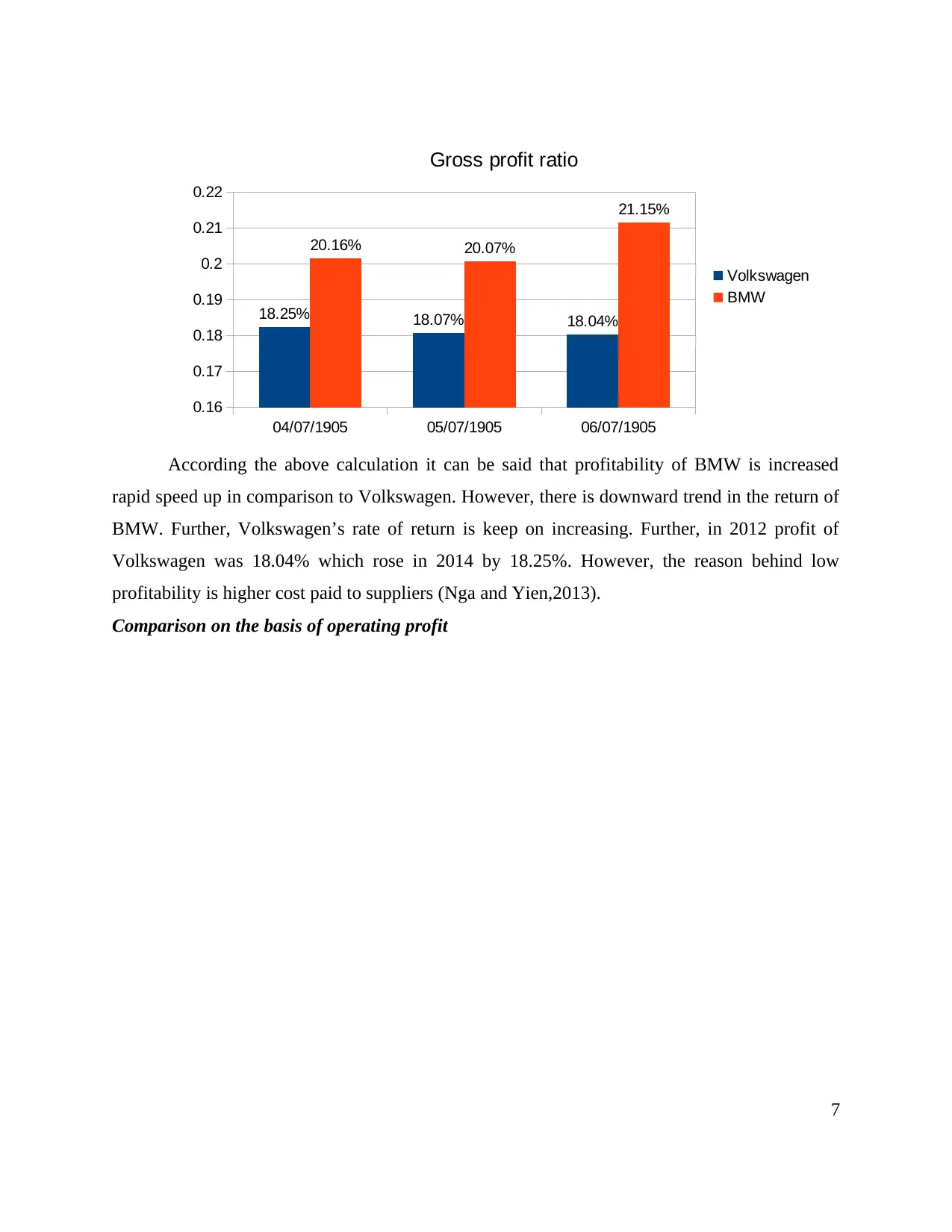
rapid speed up in comparison to Volkswagen. However, there is downward trend in the return of
BMW. Further, Volkswagen’s rate of return is keep on increasing. Further, in 2012 profit of
Volkswagen was 18.04% which rose in 2014 by 18.25%. However, the reason behind low
profitability is higher cost paid to suppliers (Nga and Yien,2013).
Comparison on the basis of operating profit
7
04/07/1905 05/07/1905 06/07/1905
0.16
0.17
0.18
0.19
0.2
0.21
0.22
18.04%18.07%18.25%
21.15%
20.07%20.16%
Gross profit ratio
Volkswagen
BMW
Paraphrase This Document
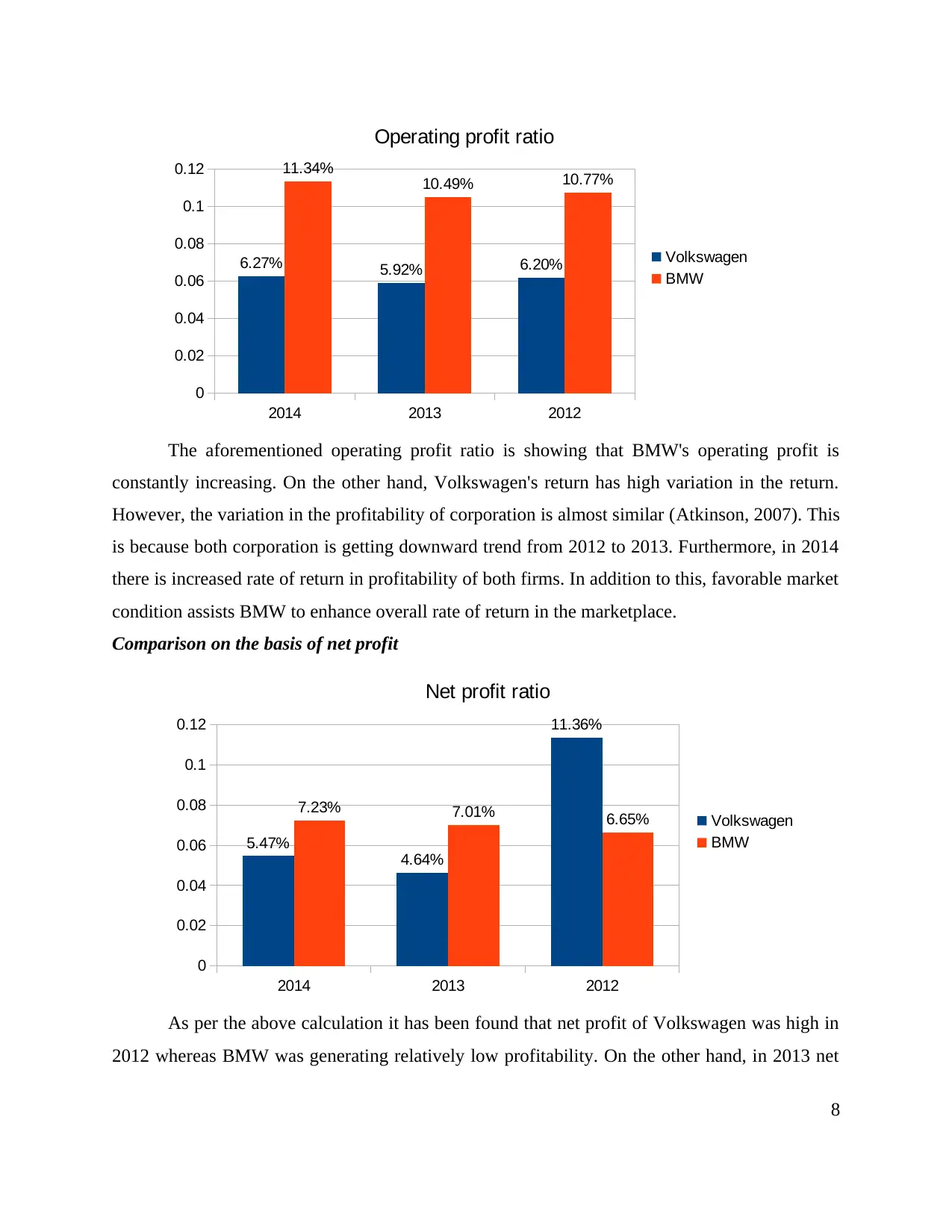
constantly increasing. On the other hand, Volkswagen's return has high variation in the return.
However, the variation in the profitability of corporation is almost similar (Atkinson, 2007). This
is because both corporation is getting downward trend from 2012 to 2013. Furthermore, in 2014
there is increased rate of return in profitability of both firms. In addition to this, favorable market
condition assists BMW to enhance overall rate of return in the marketplace.
Comparison on the basis of net profit
As per the above calculation it has been found that net profit of Volkswagen was high in
2012 whereas BMW was generating relatively low profitability. On the other hand, in 2013 net
8
2014 2013 2012
0
0.02
0.04
0.06
0.08
0.1
0.12
6.27% 5.92% 6.20%
11.34%
10.49% 10.77%
Operating profit ratio
Volkswagen
BMW
2014 2013 2012
0
0.02
0.04
0.06
0.08
0.1
0.12
5.47%
4.64%
11.36%
7.23% 7.01% 6.65%
Net profit ratio
Volkswagen
BMW
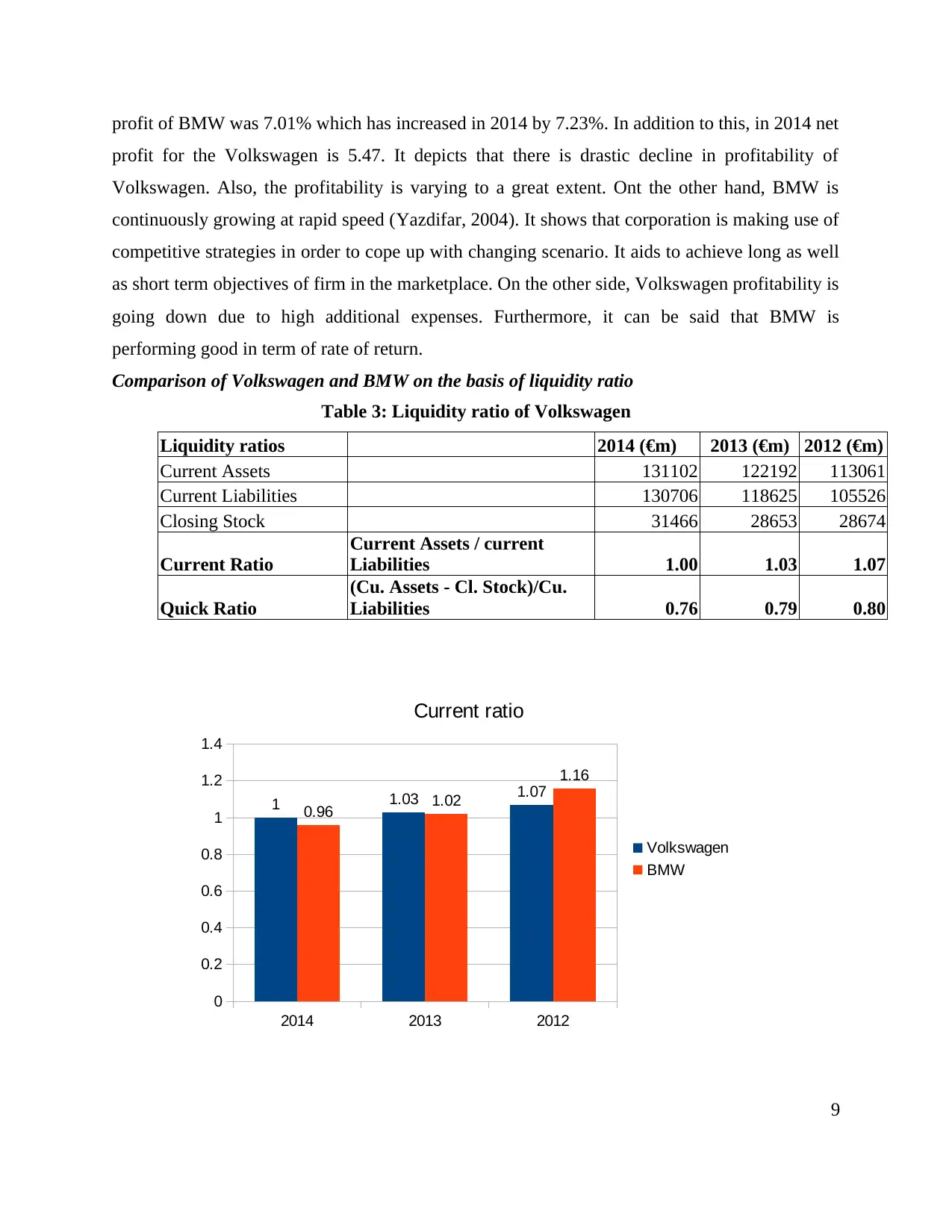
profit for the Volkswagen is 5.47. It depicts that there is drastic decline in profitability of
Volkswagen. Also, the profitability is varying to a great extent. Ont the other hand, BMW is
continuously growing at rapid speed (Yazdifar, 2004). It shows that corporation is making use of
competitive strategies in order to cope up with changing scenario. It aids to achieve long as well
as short term objectives of firm in the marketplace. On the other side, Volkswagen profitability is
going down due to high additional expenses. Furthermore, it can be said that BMW is
performing good in term of rate of return.
Comparison of Volkswagen and BMW on the basis of liquidity ratio
Table 3: Liquidity ratio of Volkswagen
Liquidity ratios 2014 (€m) 2013 (€m) 2012 (€m)
Current Assets 131102 122192 113061
Current Liabilities 130706 118625 105526
Closing Stock 31466 28653 28674
Current Ratio
Current Assets / current
Liabilities 1.00 1.03 1.07
Quick Ratio
(Cu. Assets - Cl. Stock)/Cu.
Liabilities 0.76 0.79 0.80
9
2014 2013 2012
0
0.2
0.4
0.6
0.8
1
1.2
1.4
1 1.03 1.07
0.96 1.02
1.16
Current ratio
Volkswagen
BMW
⊘ This is a preview!⊘
Do you want full access?
Subscribe today to unlock all pages.

Trusted by 1+ million students worldwide
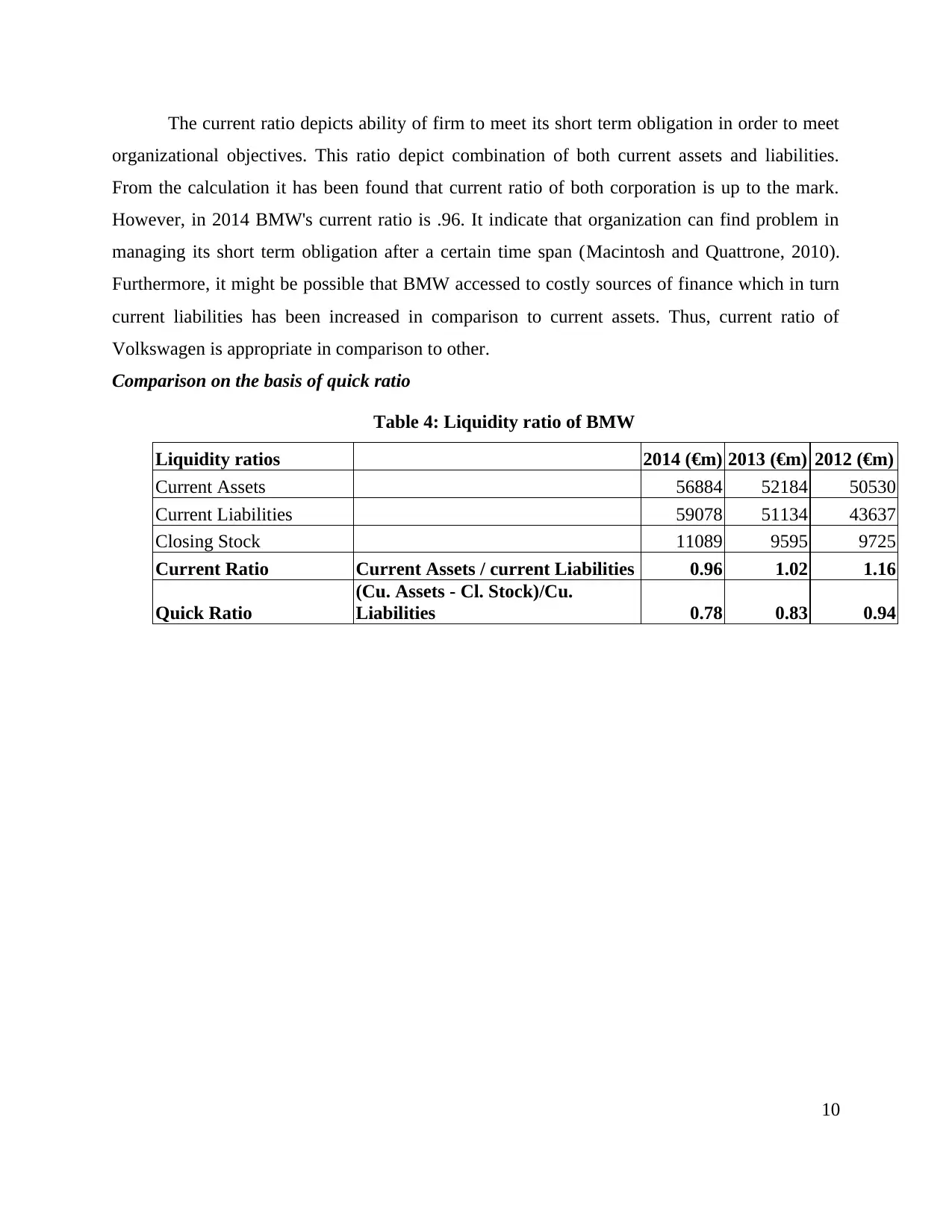
organizational objectives. This ratio depict combination of both current assets and liabilities.
From the calculation it has been found that current ratio of both corporation is up to the mark.
However, in 2014 BMW's current ratio is .96. It indicate that organization can find problem in
managing its short term obligation after a certain time span (Macintosh and Quattrone, 2010).
Furthermore, it might be possible that BMW accessed to costly sources of finance which in turn
current liabilities has been increased in comparison to current assets. Thus, current ratio of
Volkswagen is appropriate in comparison to other.
Comparison on the basis of quick ratio
Table 4: Liquidity ratio of BMW
Liquidity ratios 2014 (€m) 2013 (€m) 2012 (€m)
Current Assets 56884 52184 50530
Current Liabilities 59078 51134 43637
Closing Stock 11089 9595 9725
Current Ratio Current Assets / current Liabilities 0.96 1.02 1.16
Quick Ratio
(Cu. Assets - Cl. Stock)/Cu.
Liabilities 0.78 0.83 0.94
10
Paraphrase This Document
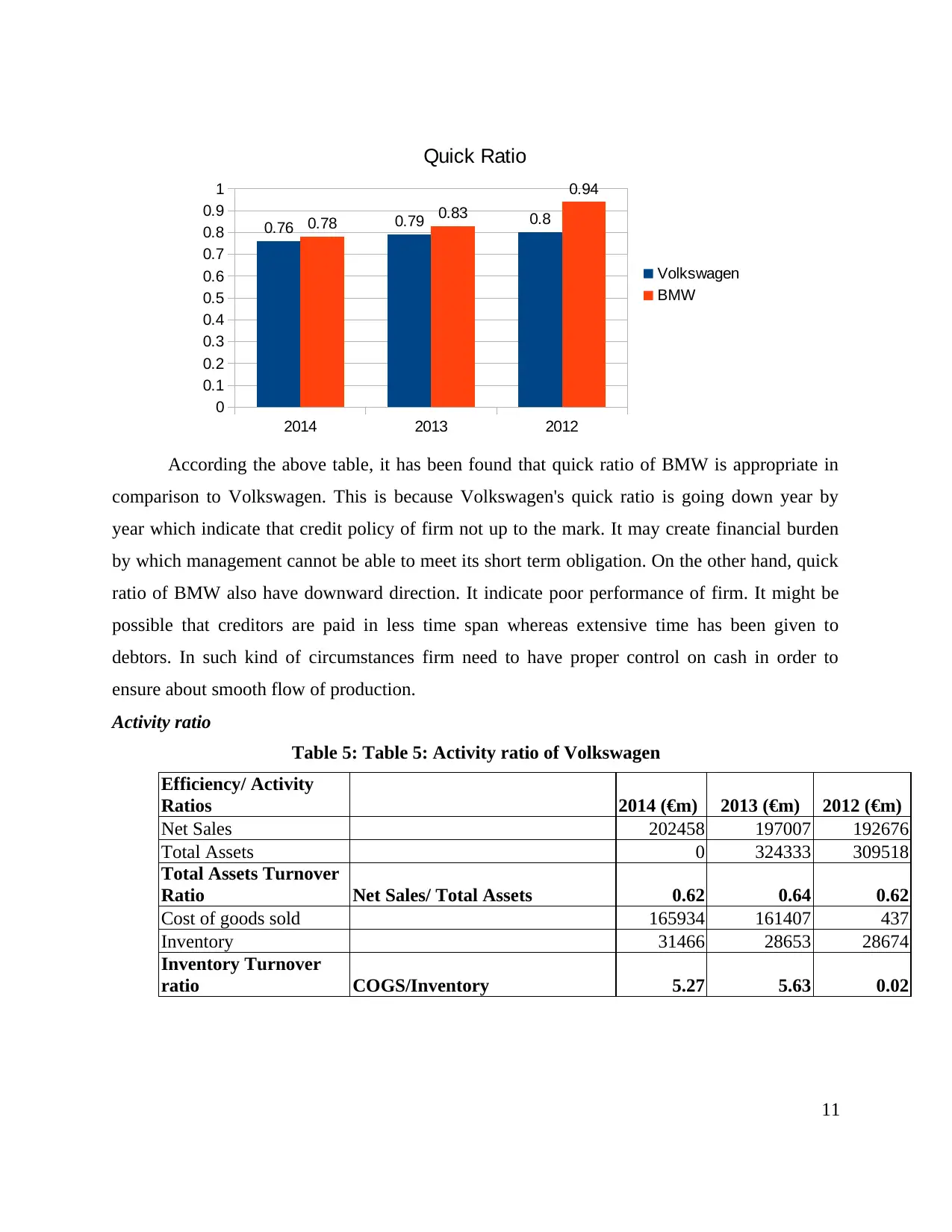
comparison to Volkswagen. This is because Volkswagen's quick ratio is going down year by
year which indicate that credit policy of firm not up to the mark. It may create financial burden
by which management cannot be able to meet its short term obligation. On the other hand, quick
ratio of BMW also have downward direction. It indicate poor performance of firm. It might be
possible that creditors are paid in less time span whereas extensive time has been given to
debtors. In such kind of circumstances firm need to have proper control on cash in order to
ensure about smooth flow of production.
Activity ratio
Table 5: Table 5: Activity ratio of Volkswagen
Efficiency/ Activity
Ratios 2014 (€m) 2013 (€m) 2012 (€m)
Net Sales 202458 197007 192676
Total Assets 0 324333 309518
Total Assets Turnover
Ratio Net Sales/ Total Assets 0.62 0.64 0.62
Cost of goods sold 165934 161407 437
Inventory 31466 28653 28674
Inventory Turnover
ratio COGS/Inventory 5.27 5.63 0.02
11
2014 2013 2012
0
0.1
0.2
0.3
0.4
0.5
0.6
0.7
0.8
0.9
1
0.76 0.79 0.80.78 0.83
0.94
Quick Ratio
Volkswagen
BMW
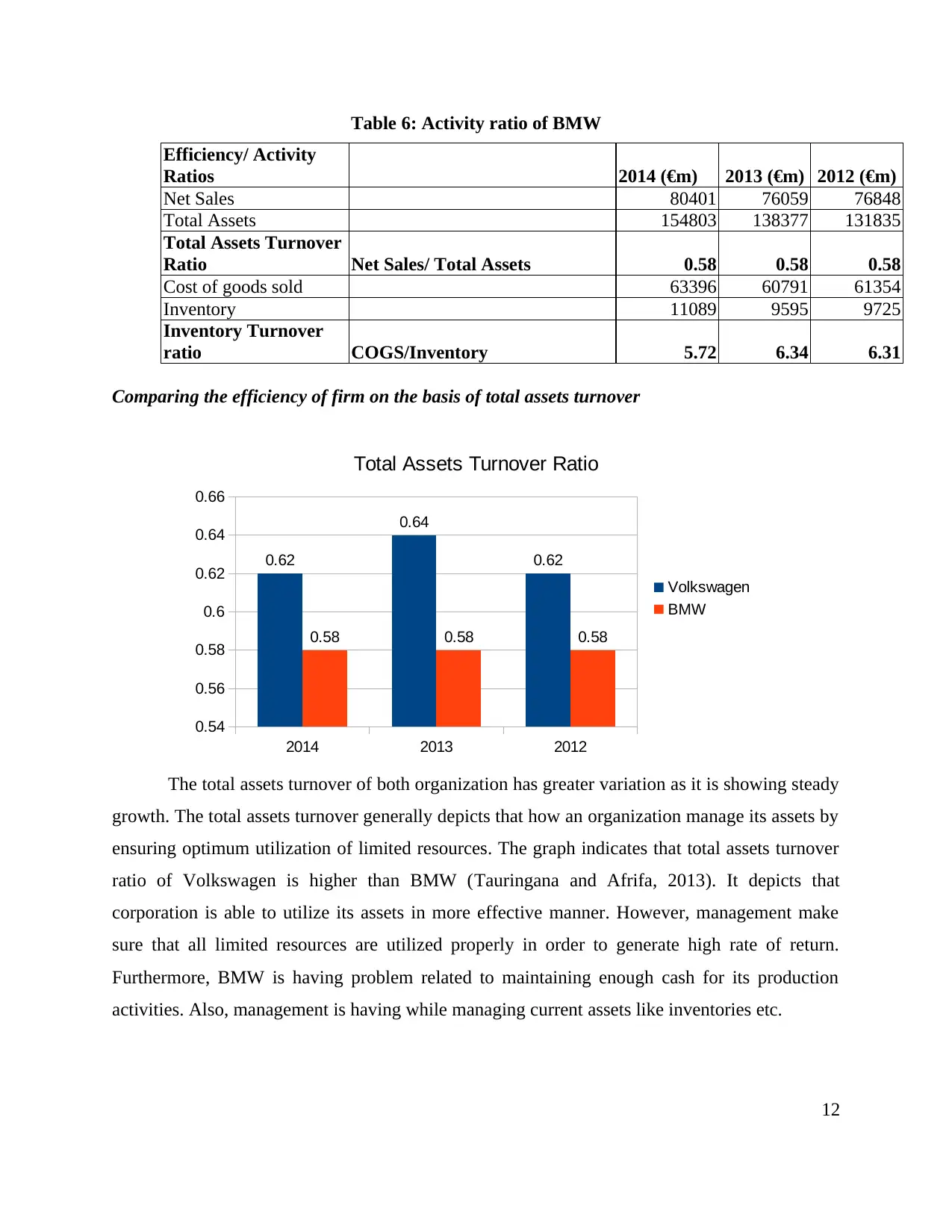
Efficiency/ Activity
Ratios 2014 (€m) 2013 (€m) 2012 (€m)
Net Sales 80401 76059 76848
Total Assets 154803 138377 131835
Total Assets Turnover
Ratio Net Sales/ Total Assets 0.58 0.58 0.58
Cost of goods sold 63396 60791 61354
Inventory 11089 9595 9725
Inventory Turnover
ratio COGS/Inventory 5.72 6.34 6.31
Comparing the efficiency of firm on the basis of total assets turnover
The total assets turnover of both organization has greater variation as it is showing steady
growth. The total assets turnover generally depicts that how an organization manage its assets by
ensuring optimum utilization of limited resources. The graph indicates that total assets turnover
ratio of Volkswagen is higher than BMW (Tauringana and Afrifa, 2013). It depicts that
corporation is able to utilize its assets in more effective manner. However, management make
sure that all limited resources are utilized properly in order to generate high rate of return.
Furthermore, BMW is having problem related to maintaining enough cash for its production
activities. Also, management is having while managing current assets like inventories etc.
12
2014 2013 2012
0.54
0.56
0.58
0.6
0.62
0.64
0.66
0.62
0.64
0.62
0.58 0.58 0.58
Total Assets Turnover Ratio
Volkswagen
BMW
⊘ This is a preview!⊘
Do you want full access?
Subscribe today to unlock all pages.

Trusted by 1+ million students worldwide
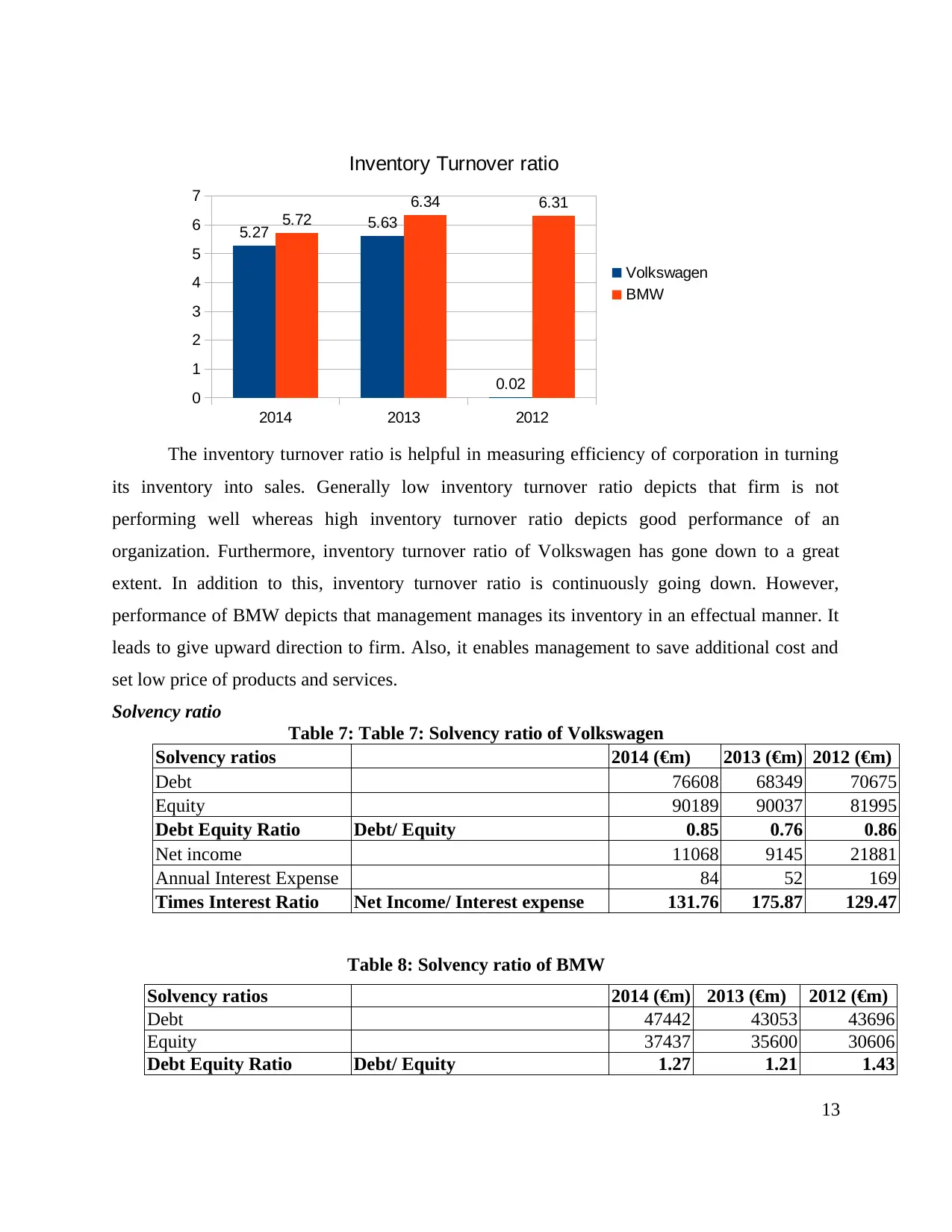
its inventory into sales. Generally low inventory turnover ratio depicts that firm is not
performing well whereas high inventory turnover ratio depicts good performance of an
organization. Furthermore, inventory turnover ratio of Volkswagen has gone down to a great
extent. In addition to this, inventory turnover ratio is continuously going down. However,
performance of BMW depicts that management manages its inventory in an effectual manner. It
leads to give upward direction to firm. Also, it enables management to save additional cost and
set low price of products and services.
Solvency ratio
Table 7: Table 7: Solvency ratio of Volkswagen
Solvency ratios 2014 (€m) 2013 (€m) 2012 (€m)
Debt 76608 68349 70675
Equity 90189 90037 81995
Debt Equity Ratio Debt/ Equity 0.85 0.76 0.86
Net income 11068 9145 21881
Annual Interest Expense 84 52 169
Times Interest Ratio Net Income/ Interest expense 131.76 175.87 129.47
Table 8: Solvency ratio of BMW
Solvency ratios 2014 (€m) 2013 (€m) 2012 (€m)
Debt 47442 43053 43696
Equity 37437 35600 30606
Debt Equity Ratio Debt/ Equity 1.27 1.21 1.43
13
2014 2013 2012
0
1
2
3
4
5
6
7
5.27 5.63
0.02
5.72
6.34 6.31
Inventory Turnover ratio
Volkswagen
BMW
Paraphrase This Document
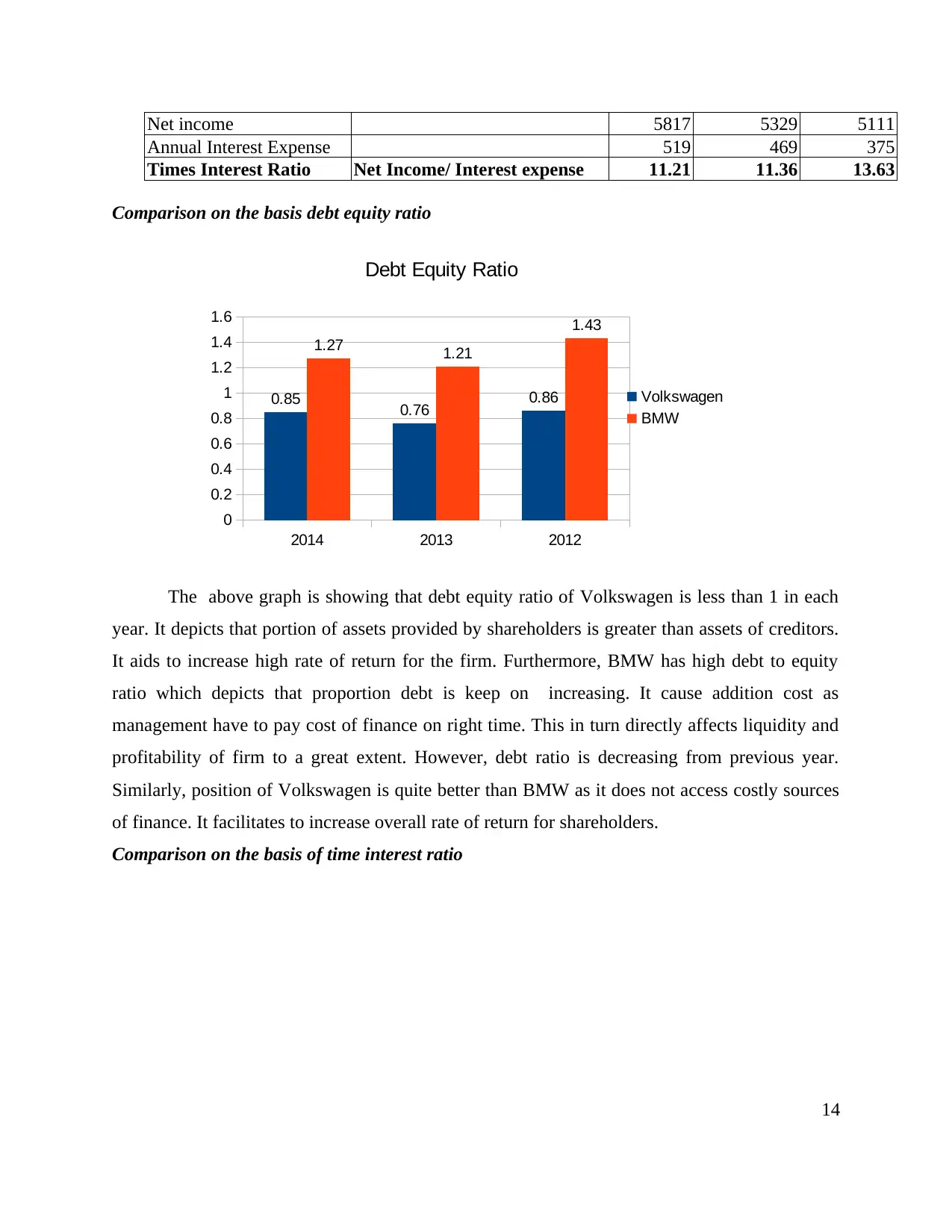
Annual Interest Expense 519 469 375
Times Interest Ratio Net Income/ Interest expense 11.21 11.36 13.63
Comparison on the basis debt equity ratio
The above graph is showing that debt equity ratio of Volkswagen is less than 1 in each
year. It depicts that portion of assets provided by shareholders is greater than assets of creditors.
It aids to increase high rate of return for the firm. Furthermore, BMW has high debt to equity
ratio which depicts that proportion debt is keep on increasing. It cause addition cost as
management have to pay cost of finance on right time. This in turn directly affects liquidity and
profitability of firm to a great extent. However, debt ratio is decreasing from previous year.
Similarly, position of Volkswagen is quite better than BMW as it does not access costly sources
of finance. It facilitates to increase overall rate of return for shareholders.
Comparison on the basis of time interest ratio
14
2014 2013 2012
0
0.2
0.4
0.6
0.8
1
1.2
1.4
1.6
0.85 0.76 0.86
1.27 1.21
1.43
Debt Equity Ratio
Volkswagen
BMW
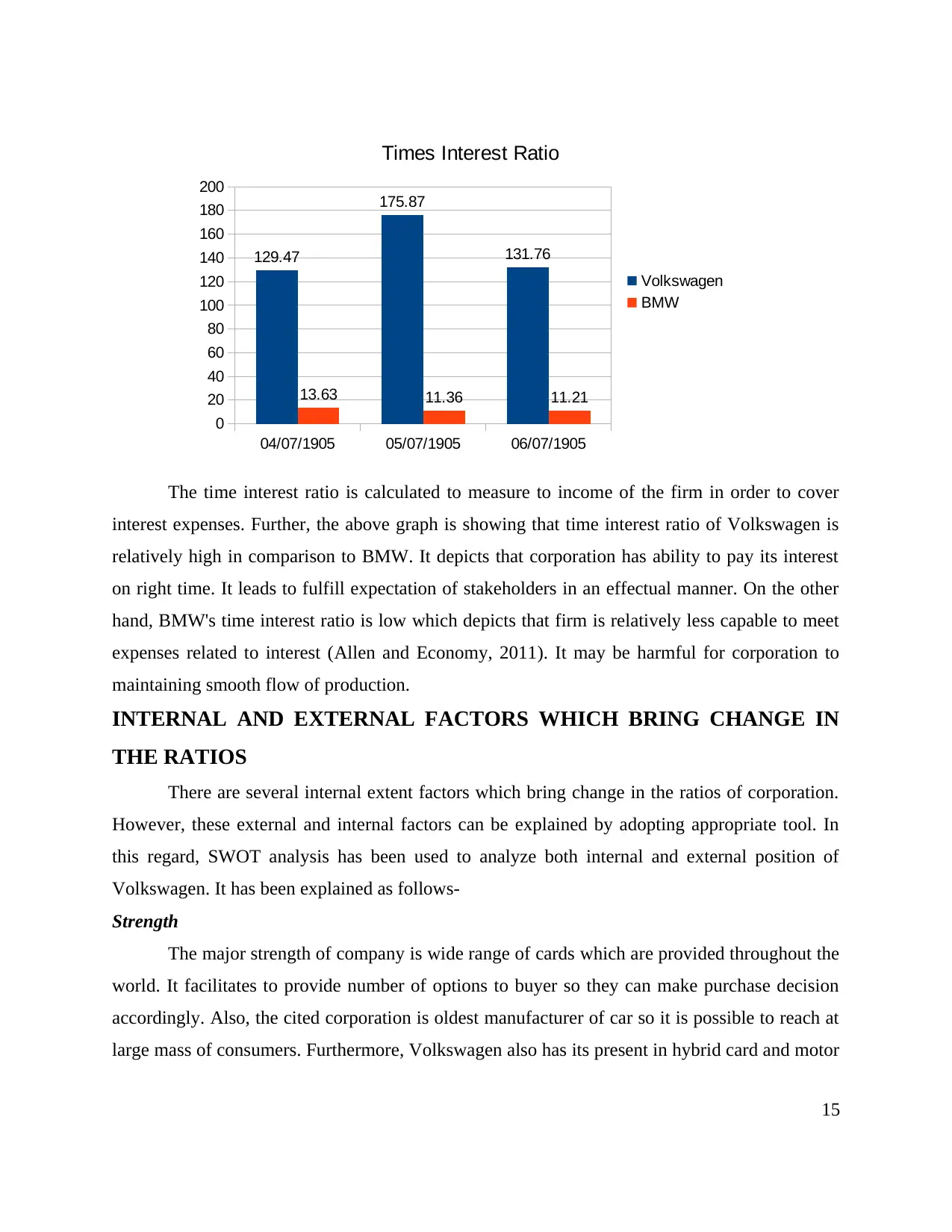
interest expenses. Further, the above graph is showing that time interest ratio of Volkswagen is
relatively high in comparison to BMW. It depicts that corporation has ability to pay its interest
on right time. It leads to fulfill expectation of stakeholders in an effectual manner. On the other
hand, BMW's time interest ratio is low which depicts that firm is relatively less capable to meet
expenses related to interest (Allen and Economy, 2011). It may be harmful for corporation to
maintaining smooth flow of production.
INTERNAL AND EXTERNAL FACTORS WHICH BRING CHANGE IN
THE RATIOS
There are several internal extent factors which bring change in the ratios of corporation.
However, these external and internal factors can be explained by adopting appropriate tool. In
this regard, SWOT analysis has been used to analyze both internal and external position of
Volkswagen. It has been explained as follows-
Strength
The major strength of company is wide range of cards which are provided throughout the
world. It facilitates to provide number of options to buyer so they can make purchase decision
accordingly. Also, the cited corporation is oldest manufacturer of car so it is possible to reach at
large mass of consumers. Furthermore, Volkswagen also has its present in hybrid card and motor
15
04/07/1905 05/07/1905 06/07/1905
0
20
40
60
80
100
120
140
160
180
200
131.76
175.87
129.47
11.2111.3613.63
Times Interest Ratio
Volkswagen
BMW
⊘ This is a preview!⊘
Do you want full access?
Subscribe today to unlock all pages.

Trusted by 1+ million students worldwide
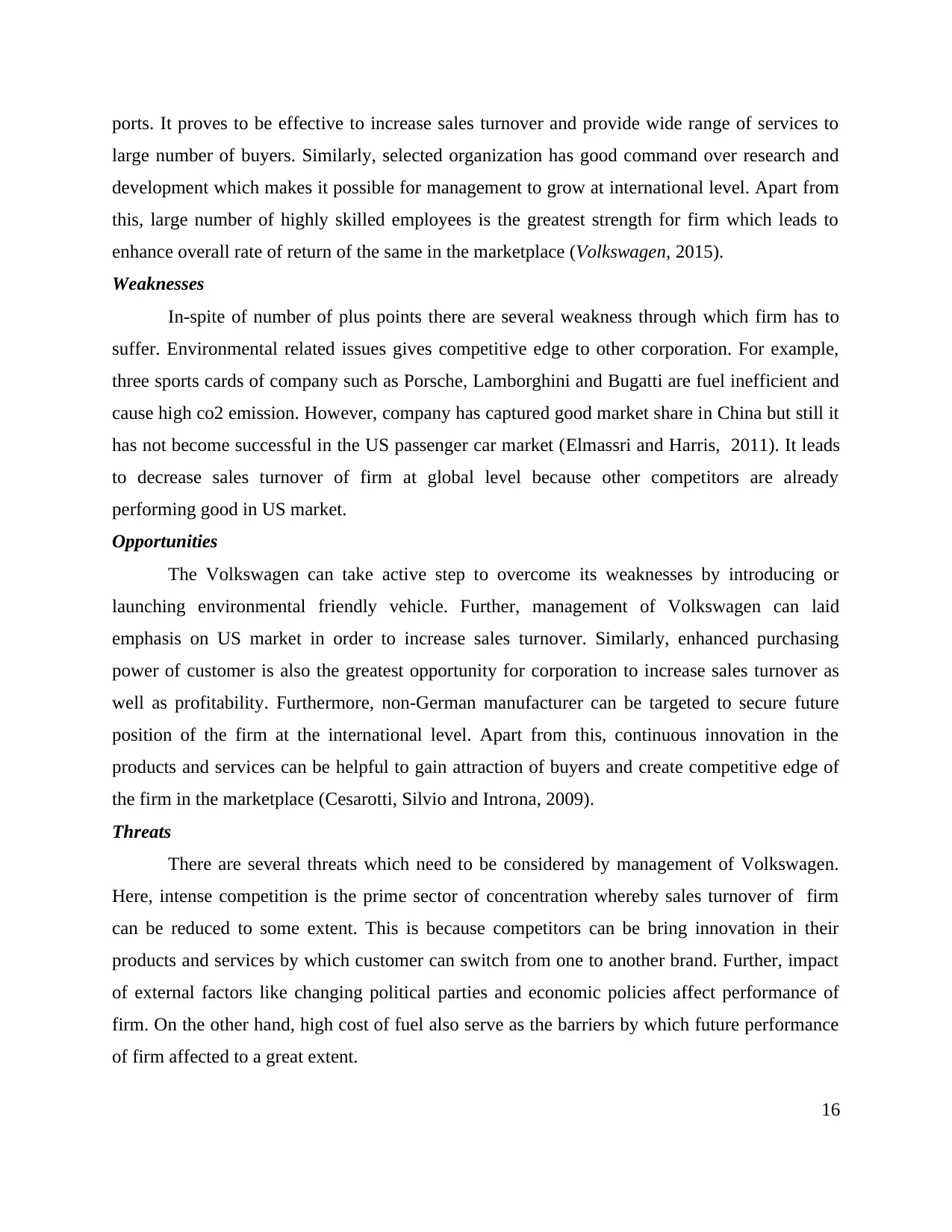
large number of buyers. Similarly, selected organization has good command over research and
development which makes it possible for management to grow at international level. Apart from
this, large number of highly skilled employees is the greatest strength for firm which leads to
enhance overall rate of return of the same in the marketplace (Volkswagen, 2015).
Weaknesses
In-spite of number of plus points there are several weakness through which firm has to
suffer. Environmental related issues gives competitive edge to other corporation. For example,
three sports cards of company such as Porsche, Lamborghini and Bugatti are fuel inefficient and
cause high co2 emission. However, company has captured good market share in China but still it
has not become successful in the US passenger car market (Elmassri and Harris, 2011). It leads
to decrease sales turnover of firm at global level because other competitors are already
performing good in US market.
Opportunities
The Volkswagen can take active step to overcome its weaknesses by introducing or
launching environmental friendly vehicle. Further, management of Volkswagen can laid
emphasis on US market in order to increase sales turnover. Similarly, enhanced purchasing
power of customer is also the greatest opportunity for corporation to increase sales turnover as
well as profitability. Furthermore, non-German manufacturer can be targeted to secure future
position of the firm at the international level. Apart from this, continuous innovation in the
products and services can be helpful to gain attraction of buyers and create competitive edge of
the firm in the marketplace (Cesarotti, Silvio and Introna, 2009).
Threats
There are several threats which need to be considered by management of Volkswagen.
Here, intense competition is the prime sector of concentration whereby sales turnover of firm
can be reduced to some extent. This is because competitors can be bring innovation in their
products and services by which customer can switch from one to another brand. Further, impact
of external factors like changing political parties and economic policies affect performance of
firm. On the other hand, high cost of fuel also serve as the barriers by which future performance
of firm affected to a great extent.
16
Paraphrase This Document
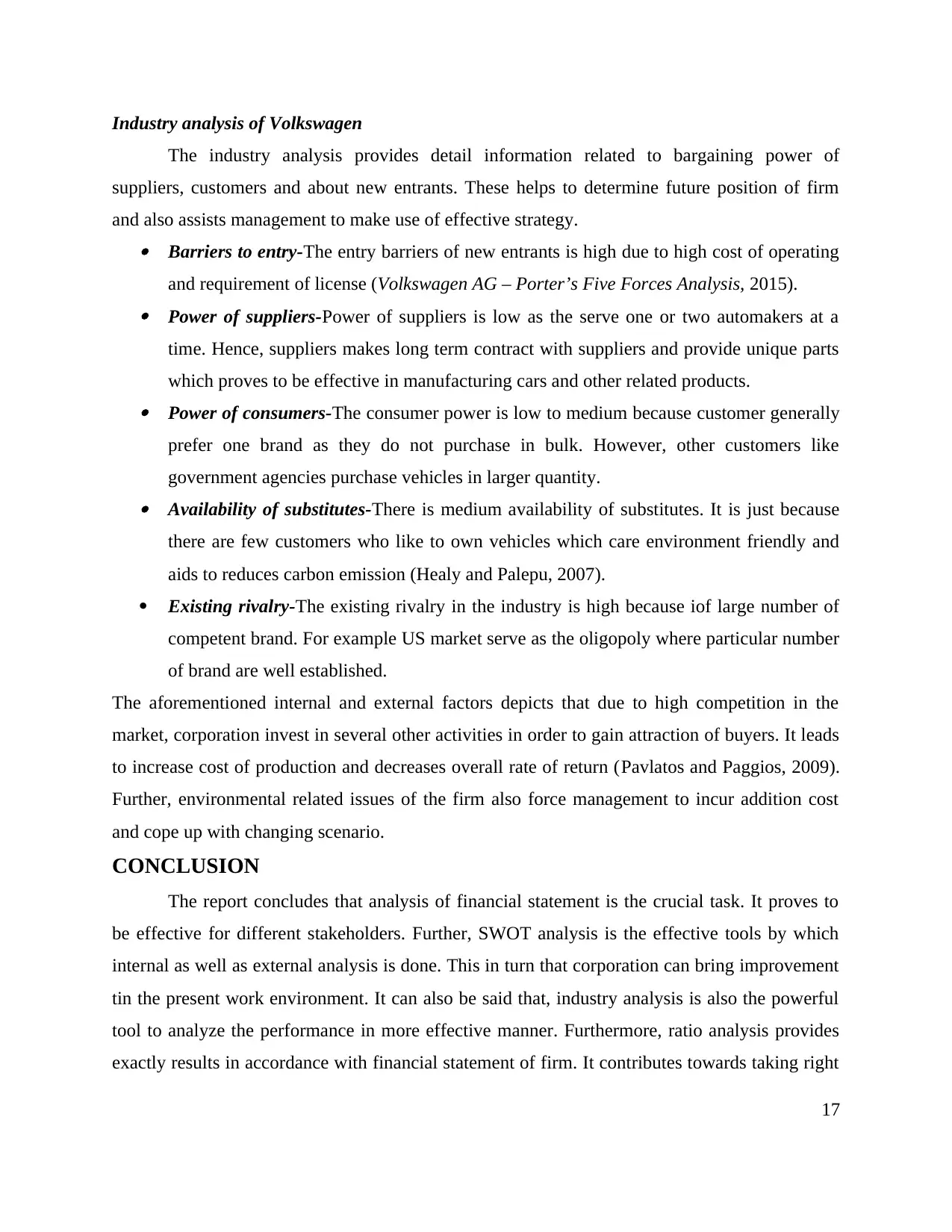
The industry analysis provides detail information related to bargaining power of
suppliers, customers and about new entrants. These helps to determine future position of firm
and also assists management to make use of effective strategy. Barriers to entry-The entry barriers of new entrants is high due to high cost of operating
and requirement of license (Volkswagen AG – Porter’s Five Forces Analysis, 2015). Power of suppliers-Power of suppliers is low as the serve one or two automakers at a
time. Hence, suppliers makes long term contract with suppliers and provide unique parts
which proves to be effective in manufacturing cars and other related products. Power of consumers-The consumer power is low to medium because customer generally
prefer one brand as they do not purchase in bulk. However, other customers like
government agencies purchase vehicles in larger quantity. Availability of substitutes-There is medium availability of substitutes. It is just because
there are few customers who like to own vehicles which care environment friendly and
aids to reduces carbon emission (Healy and Palepu, 2007).
Existing rivalry-The existing rivalry in the industry is high because iof large number of
competent brand. For example US market serve as the oligopoly where particular number
of brand are well established.
The aforementioned internal and external factors depicts that due to high competition in the
market, corporation invest in several other activities in order to gain attraction of buyers. It leads
to increase cost of production and decreases overall rate of return (Pavlatos and Paggios, 2009).
Further, environmental related issues of the firm also force management to incur addition cost
and cope up with changing scenario.
CONCLUSION
The report concludes that analysis of financial statement is the crucial task. It proves to
be effective for different stakeholders. Further, SWOT analysis is the effective tools by which
internal as well as external analysis is done. This in turn that corporation can bring improvement
tin the present work environment. It can also be said that, industry analysis is also the powerful
tool to analyze the performance in more effective manner. Furthermore, ratio analysis provides
exactly results in accordance with financial statement of firm. It contributes towards taking right
17
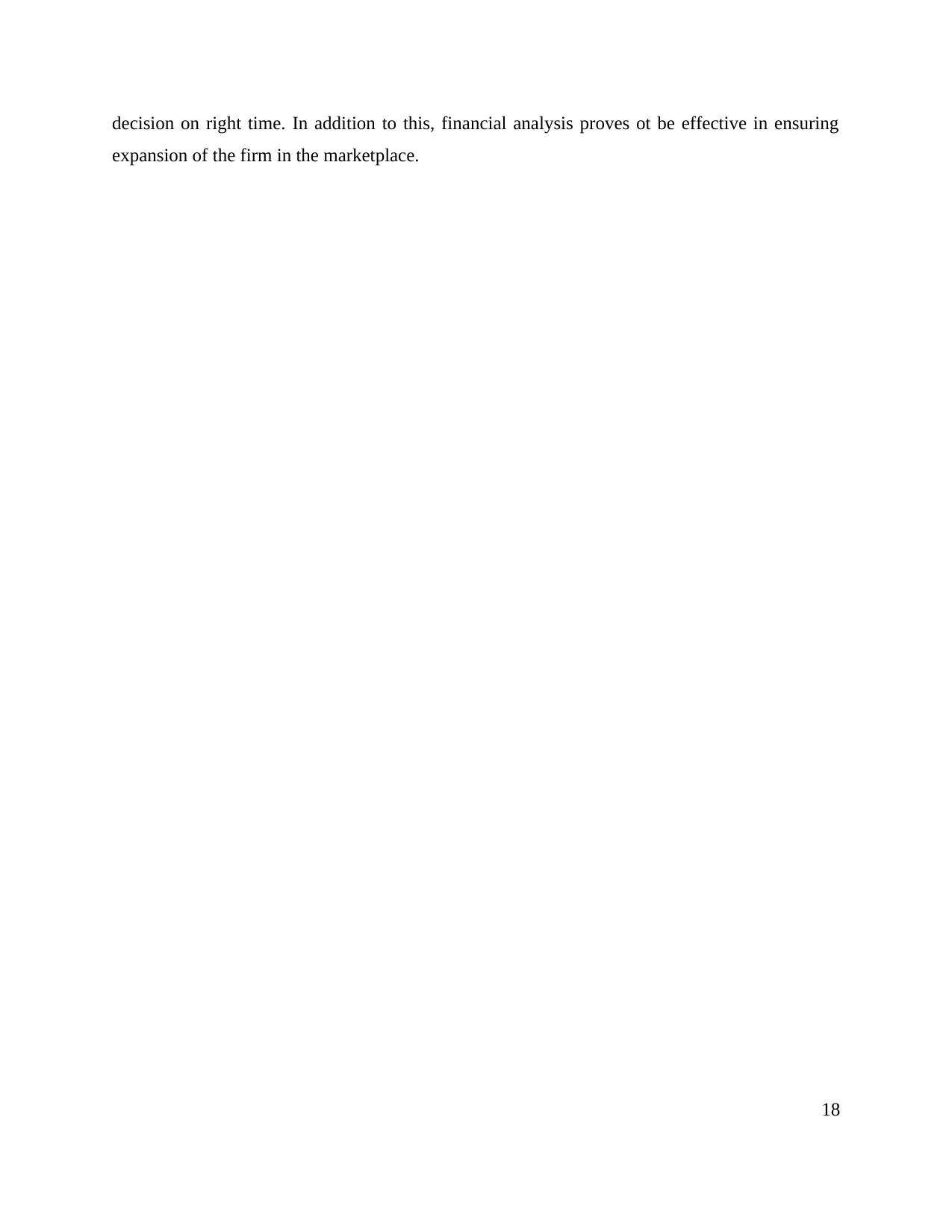
expansion of the firm in the marketplace.
18
⊘ This is a preview!⊘
Do you want full access?
Subscribe today to unlock all pages.

Trusted by 1+ million students worldwide
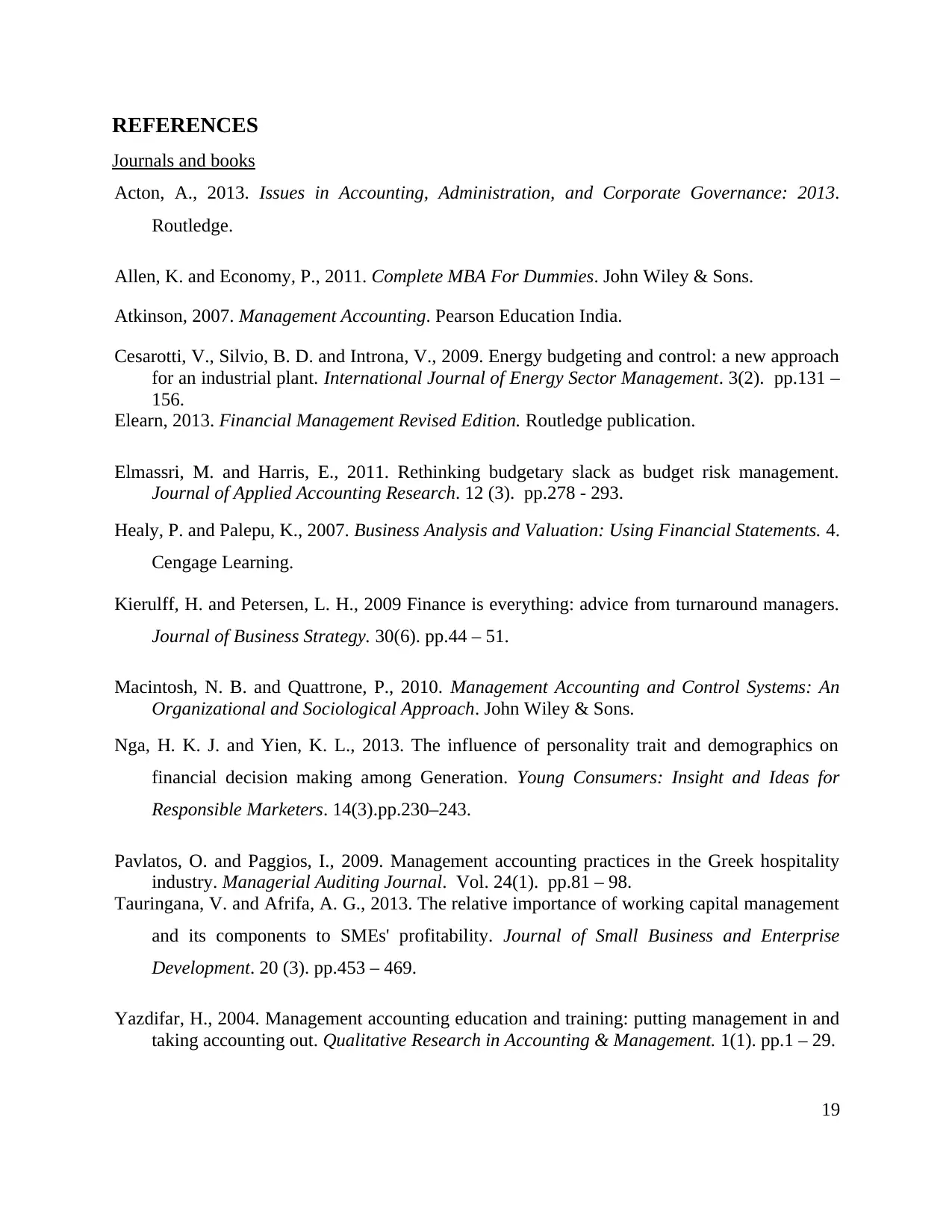
Journals and books
Acton, A., 2013. Issues in Accounting, Administration, and Corporate Governance: 2013.
Routledge.
Allen, K. and Economy, P., 2011. Complete MBA For Dummies. John Wiley & Sons.
Atkinson, 2007. Management Accounting. Pearson Education India.
Cesarotti, V., Silvio, B. D. and Introna, V., 2009. Energy budgeting and control: a new approach
for an industrial plant. International Journal of Energy Sector Management. 3(2). pp.131 –
156.
Elearn, 2013. Financial Management Revised Edition. Routledge publication.
Elmassri, M. and Harris, E., 2011. Rethinking budgetary slack as budget risk management.
Journal of Applied Accounting Research. 12 (3). pp.278 - 293.
Healy, P. and Palepu, K., 2007. Business Analysis and Valuation: Using Financial Statements. 4.
Cengage Learning.
Kierulff, H. and Petersen, L. H., 2009 Finance is everything: advice from turnaround managers.
Journal of Business Strategy. 30(6). pp.44 – 51.
Macintosh, N. B. and Quattrone, P., 2010. Management Accounting and Control Systems: An
Organizational and Sociological Approach. John Wiley & Sons.
Nga, H. K. J. and Yien, K. L., 2013. The influence of personality trait and demographics on
financial decision making among Generation. Young Consumers: Insight and Ideas for
Responsible Marketers. 14(3).pp.230–243.
Pavlatos, O. and Paggios, I., 2009. Management accounting practices in the Greek hospitality
industry. Managerial Auditing Journal. Vol. 24(1). pp.81 – 98.
Tauringana, V. and Afrifa, A. G., 2013. The relative importance of working capital management
and its components to SMEs' profitability. Journal of Small Business and Enterprise
Development. 20 (3). pp.453 – 469.
Yazdifar, H., 2004. Management accounting education and training: putting management in and
taking accounting out. Qualitative Research in Accounting & Management. 1(1). pp.1 – 29.
19
Paraphrase This Document

Volkswagen AG – Porter’s Five Forces Analysis. 2015. [Online]. Available through:
<https://blogs.ubc.ca/willzhang8/2014/11/08/porters-five-forces-volkswagen-ag/>.
[Accessed on 28th October 2015].
Volkswagen. 2015. [Online]. Available through:
<http://www.mbaskool.com/brandguide/automobiles/1527-volkswagen.html>. [Accessed
on 28th October 2015].
20
Related Documents
Your All-in-One AI-Powered Toolkit for Academic Success.
+13062052269
info@desklib.com
Available 24*7 on WhatsApp / Email
![[object Object]](/_next/static/media/star-bottom.7253800d.svg)
© 2024 | Zucol Services PVT LTD | All rights reserved.





